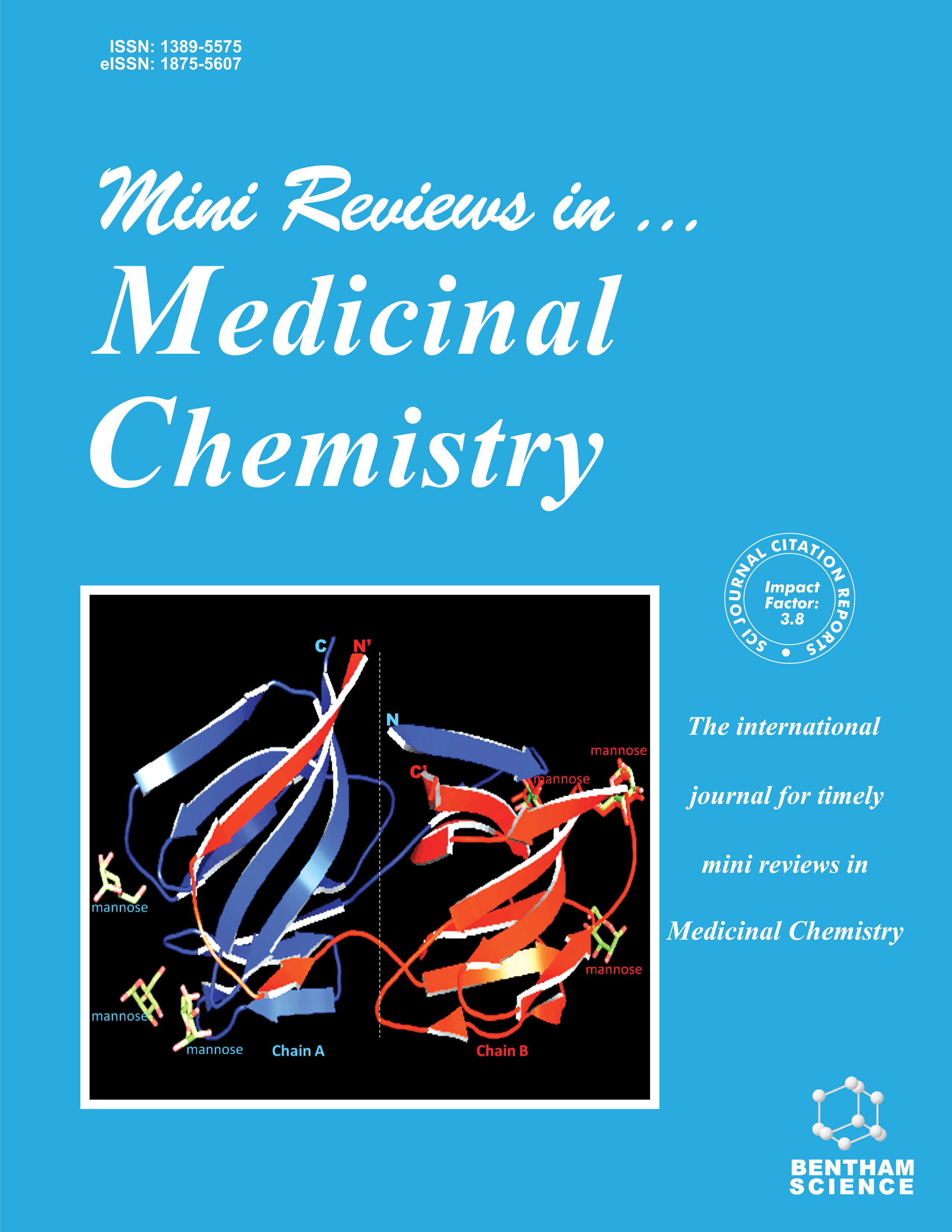- Home
- A-Z Publications
- Mini Reviews in Medicinal Chemistry
- Previous Issues
- Volume 21, Issue 20, 2021
Mini Reviews in Medicinal Chemistry - Volume 21, Issue 20, 2021
Volume 21, Issue 20, 2021
-
-
Radioprotectors: Nature’s Boon
More LessAuthors: Damanpreet K. Lang, Harwinder Singh, Arpita Arora, Rashmi Arora, Balraj Saini, Sandeep Arora and Rajwinder KaurBackground: Major approach in controlling as well as eradicating the cancerous growth is through radiotherapy, but this treatment leads to toxicity in the normal cells, leading to secondary malignancies, teratogenesis, and necrosis. More than 15,000 malignancies occur due to exposure to harmful radiations during computed tomography scans. Natural products are non-toxic; there have been reports that herbal products, w Read More
-
-
-
Carica papaya in Cancer Prevention: An Overview
More LessAuthors: Maruthanila V.L., Elancheran Ramakrishnan and Mirunalini SankaranAbstract: Carica papaya is an essential medicinal plant having anticancer activities through diverse mechanisms and is not so far thoroughly investigated. In this review, we have summarized the systematic research outputs of different parts of the papaya plant extracts and elaborated the role of its phytochemicals, anticancer activities, therapeutic targets and mechanisms. Several phenolic compounds have been identi Read More
-
-
-
A Comprehensive Review of Garcinia pedunculata Roxb. and its Therapeutic Potential
More LessAuthors: Swarnali Bhattacharjee and Rajlakshmi DeviAbstract: Garcinia pedunculata Roxb.(GP) belongs to the family of Clusiaceae and is an evergreen tree that grows in semi-wild conditions and is widely distributed throughout the Northeastern part of India. Traditionally, this plant is believed to be of immense medicinal importance and is used for the treatment of various ailments. In Assam, the acidic fruit of GP is effectively used in folklore medicine to treat gastrointestinal diso Read More
-
-
-
Dual Aromatase-Sulphatase Inhibitors (DASIs) for the Treatment of Hormone Dependent Breast Cancer
More LessAuthors: Laxmi Banjare, Akhlesh K. Jain and Suresh TharejaAbstract: Breast cancer is the most frequently diagnosed cancer in women and the second most common form of cancer, causing death after lung cancer, all across the globe at an alarming rate. The level of estrogens in breast cancer tissues of postmenopausal women is 10-40 folds higher than the non-carcinogenic breast tissues. As a result of this greater level of estrogen, breast tissue becomes more prone to develop bre Read More
-
-
-
Role of GLP-1 Analogs in the Management of Diabetes and its Secondary Complication
More LessAbstract: The cardiovascular complications of Type 2 Diabetes Mellitus (T2DM) including myocardial infarction, heart failure, peripheral vascular disease and, stroke and retinopathy, nephropathy and neuropathy are microvascular complications. While the newer therapies like glitazones or even Dipeptidyl- peptidase-IV (DPP-IV) inhibitors increase the risk of therapy, the Glucagon Like Peptide-1 Receptor Agonists (GLP-1RAs), Read More
-
-
-
Chemistry, Pharmacokinetics, Pharmacodynamics and Analytical Methods of Bilastine, a Histamine H1 Receptor Antagonist: An Update
More LessAuthors: Sanjay Sharma, Ketan Hatware, Prashant Bhadane and Kiran PatilAbstract: Bilastine (BIL) is the new generation antihistamine that is used to relieve the symptoms of hayfever, chronic urticaria and other forms of allergic rhinitis. Chemically it is known 2-[4-[2-[4-[1- (2-ethoxyethyl) benzimidazole-2-yl] piperidine-1-yl] ethyl] phenyl]-2-methylpropane acid. The chemical structure of BIL having a hydrophilic carboxylic substituent. BIL has a longer duration of action due to its potent binding affinity Read More
-
-
-
Elucidating the Drug Repurposing Spectra of COVID-19 with its Analogues SARS and MERS
More LessAuthors: Jayanti Mishra, Chakrawarti Prasun, Pravat K. Sahoo and Maya S. NairAbstract: Corona Virus Disease-2019 (COVID-19), caused by the SARS CoV-2 virus, has been announced as a pandemic by the World Health Organization. COVID-19 has affected people globally, infecting more than 39.8 million people and claiming up to 1.11 million lives, yet there is no effective treatment strategy to cure this disease. As vaccine development is a time-consuming process, currently, efforts are being mad Read More
-
-
-
Janus Kinase Inhibitors: A Review of Their Application in the Vitiligo
More LessAuthors: Chao Niu, Hunjun Xie and Haji A. AisaAbstract: The small-molecular inhibitors targeted JAks (JAK inhibitors) could modulate the cytokines- mediated signaling via the JAK-STAT pathway, which plays an important role in immune regulation and cell proliferation. The JAK inhibitors were previously designed and synthesized to treat diseases involving the hematologic and immune system. Increasing evidence shows that they are quite effective in Atopic Dermatitis (A Read More
-
-
-
Exploration of Potent Multi-target-directed-ligands as Anti-alzheimer’s Disease Agents: A Moiety Based Review
More LessAuthors: Pankaj Teli, Nusrat Sahiba, Jay Soni, Ayushi Sethiya, Dinesh K. Agarwal and Shikha AgarwalAbstract: Dementia is a chronic neurodegenerative disease, and a maximum number of the cases are directly related to Alzheimer’s disease. More than 4 million people are living with Alzheimer’s disease-related dementia in India, making it a national crisis. Alzheimer’s disease deteriorates cognitive functions with the passage of time and consists of multi-faceted factors, such as the decline of acetylcholine level, amyloid β-a Read More
-
Volumes & issues
-
Volume 25 (2025)
-
Volume 24 (2024)
-
Volume 23 (2023)
-
Volume 22 (2022)
-
Volume 21 (2021)
-
Volume 20 (2020)
-
Volume 19 (2019)
-
Volume 18 (2018)
-
Volume 17 (2017)
-
Volume 16 (2016)
-
Volume 15 (2015)
-
Volume 14 (2014)
-
Volume 13 (2013)
-
Volume 12 (2012)
-
Volume 11 (2011)
-
Volume 10 (2010)
-
Volume 9 (2009)
-
Volume 8 (2008)
-
Volume 7 (2007)
-
Volume 6 (2006)
-
Volume 5 (2005)
-
Volume 4 (2004)
-
Volume 3 (2003)
-
Volume 2 (2002)
-
Volume 1 (2001)
Most Read This Month
Article
content/journals/mrmc
Journal
10
5
false
en


